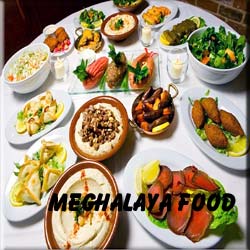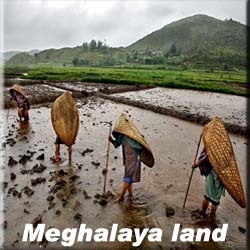CULTURE IS THE ART OF LIVING
The original tribal population of Meghalaya inhabiting the state is the Khasi and Garo who are supposed to be the parental population of Lyngngam tribes. Both the Khasi and Garo tribal groups are Tibeto-Burman or Mon-Khmer in origin. The Mon-Khmer language is spoken by the Khasi community. Some of the common languages spoken by the people of Meghalaya are Pnar-Synteng, Nepali, and Haijong and also Bengali, Assamese and Hindi to some extent. The Khansis dominate the population followed by the Garos.
The culture of Meghalaya can be best expressed as comprising the following : ORIGIN
Apart from the major groups, the other communities in minority includes Jaintias, the Koch, the Biates of Saipung Constituency and Jowai, the related Rajbongshi, the Boro, Hajong, Dimasa, Hmar, Kuki, Lakhar, Mikir, Rabha and Nepali. The eastern part of this hilly state is occupied by the Nepalis. Meghalaya is also one among the three states in India which has a majority of at least 70% of Christian population who follow Christianity. The people belonging to the Garo, Jaintia and Khasi tribes always live in peace and in a matrilineal society which means the inheritance in the family goes to the women of the house. The people of Meghalaya are physically, short, muscular and robust with fair complexion by origin. Apart from Christianity the other religions followed in minority are Islam, Buddhism and Sikhism. ETHNICITY
The original inhabitants of the state of Meghalaya belong to the tribal communities of Khasis, Jaintias, and Garos where the former two belong to the Mongolian race and the Garos belong to the Tibeto-Burman race who refer themselves as Achiks, and the land they inhabit as the Achik-land and also they belong to the Bodo family. The Jaintias who are the descendants of the Mongolian race are in turn related to the Shaan tribesmen of Myanmar. These people are said to be one of the earliest ethnic group of settlers in the Indian sub-continent, belonging to the Proto Austroloid Mon-Khmer race. The ethnicity and the culture of the people of Meghalaya are said to be unique mainly because of their geographical isolation and also the only surviving dialect of the Mon-Khmer family of languages in the country is that of the Khasis. One of the distinct traditional practice of the people of Meghalaya is the custom of passing the succession of family to the female line.CULTURE
The people of Meghalaya have a rich tribal cultural heritage. One of the distinct features of the culture of the people is their tradition of matrilineal system where lineage and inheritance are traced through women. Dance is an indispensible part of the culture of the people Meghalaya especially among the Khasi community. These dance forms depict the history or the life cycle of an individual or a village or a conglomeration of villages. These dance forms vary according to their regional taste but still portray a universal culture. The people of this community celebrate various festivals like Ka Shad Suk Mynsiem, Ka Pom-Blang Nongkrem, Ka-Shad Shyngwiang-Thangiap, Ka-Shad-Kynjoh Khaskain, Ka Bam Khana Shnong, Umsan Nongkharai, and Shad Beh Sier. According to the Jaintias culture festivals are celebrated mainly to bring a balance between man, his culture and his natural environment or eco-system. The people also believe that the celebration of festivals brings unity and good spirit among the population and the surroundings. TRADITIONS
The customs and the traditions followed by the people of Meghalaya varies to a great extent which in turn has lot of diversity among the different communities itself. It is the girl who propses a match to the boy which is very unlikely across the country and these marriages strictly follow two laws namely Exogamy and Akim in which marriages are not permitted within the same clan and also a a man or a woman who has once contracted marriage will never be free to remarry a person of another clan, even after the death of his/ her spouse. But they can marry a person from the same clan in case of the death of the spouse. Likewise if the husband is dead the wife has the right to marry one of her nephews of the deceased husband and in turn if the wife is dead the husband can marry one of the sisters of the wife. A person in the community is permitted to marry according to his or her choice only when there are no subsitutes arranged. The people of Meghalaya follow their traditional religious system which was originally a mix of Pantheism and Hinduism. The Garos believed in the 'Supreme God' as locally known as 'Dakgipa Rugipa Stugipa Pantugipa or Tatara Rabuga Stura Pantura', or the Creator and they also have faith in sin and depending on it the incarnation of the spirit in it takes place. For reconciling the spirits the people generally offer sacrifices at the time of religious ceremonies. COSTUMES
The Garo women wear an unstitched short cloth called Dakmanda around the waist which is a special hand woven cotton fabric. These cotton fabrics have beautiful borders which are about six to ten inches and are designed with attractive motifs or floral patterns. It includes a Jainsen, concealing till the ankles, which is topped off by a blouse. On top of all these garments they tie a cotton shawl which goes round the neck and then pinned at the shoulders which looks more like an apron. In case of any special occasions they adorn them with a piece of Assam Muga silk only to give a vibrant appearance. Some of the senior women of the community also wear a strip of woolen cloth called Jainkup.The women folk of the Jaintia at the time of harvest work cover their head with a cloth piece known as "Kyrshah".She covers herself from the shoulders to the ankles, with a velvet blouse, along with a sarong called Thoh Khyrwang wrapped round her waist. The men of Meghalaya usually wear dhoti kind of apparel which is mostly unstitched and they pull on a jacket along with a headgear or turban. But however now slowly western concept of dressing up is entering the realms. ARTS AND CRAFTS
The people of Meghalaya are known for their weaving skills and creating cane mats, stools, and baskets. A special kind of fabric known as dakmanda is weaved by the people of the Garo community. Tlieng is a durable variety of cane mat weaved by the people. They also weave baskets and chairs out of cane and bamboo is used to make fish traps. The 'Garo' tribe weaves 'Dakmanda', a material used for their dresses along with shirts, bed covers, bed sheets and tablecloths. Silk weaving and carpet weaving are also part of their art and crafts for which the people are famous. CUISINE

OCCUPATION

Apart from agriculture there are few small scale and medium scale industries coming up. They are also involved in furniture making. Art and craft are part of their culture.


